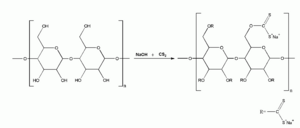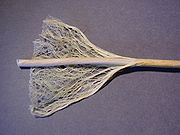Rayon
Rayon is a manufactured regenerated cellulose fiber. Because it is produced from naturally occurring polymers, it is neither a truly synthetic fiber nor a natural fiber; it is a semi-synthetic[1] or artificial[2] fiber. Rayon is known by the names viscose rayon and art silk in the textile industry. It usually has a high luster quality giving it a bright sheen.

Contents |
Uses of rayon
Some major rayon fiber uses include apparel (e.g. blouses, dresses, jackets, lingerie, linings, scarves, suits, neckties, hats, socks), the filling in Zippo lighters, furnishings (e.g. bedspreads, bedsheets, blankets, window treatments, upholstery, slipcovers), industrial uses (e.g. medical surgery products, non-woven products, tire cord), and other uses (e.g. yarn, feminine hygiene products, diapers, towels).[3] Rayon is a major feedstock in the production of carbon fiber.
In early 2010, the U.S. Federal Trade Commission warned several retailers that six major manufacturers were falsely labeling rayon products as "bamboo", in order to appeal to environmentally-conscious consumers. While rayon may be produced with bamboo as a raw material, and the two may be used for similar fabrics (though natural bamboo is not as smooth), rayon is so far removed from bamboo by chemical processing that the two are entirely separate.[4]
History
Nitrocellulose
The fact that nitrocellulose is soluble in organic solvents such as ether and acetone, made it possible for Georges Audemars to develop the first "artificial silk" about 1855, but his method was impractical for commercial use. Commercial production started in 1891, but the result was flammable, and more expensive than acetate or cuprammonium rayon. Because of this, production was stopped before World War I, for example in 1912 in Germany. Briefly, it became known as "mother-in-law silk."[5]
Nathan Rosenstein invented the spunize process by which he turned rayon from a hard fiber to a fabric. This allowed rayon to become a popular raw material in textiles.
Acetate method
Paul Schützenberger discovered that cellulose can be reacted with acetic anhydride to form cellulose acetate. The triacetate is only soluble in chloroform making the method expensive. The discovery that hydrolyzed cellulose acetate is soluble in more polar solvents, like acetone, made production of cellulose acetate fibers cheap and efficient.
Cuprammonium method
The German chemist Eduard Schweizer discovered that tetraaminecopper dihydroxide could dissolve cellulose. Max Fremery and Johann Urban developed a method to produce carbon fibers for use in light bulbs in 1897.[6] Production of rayon for textiles started in 1899 in the Vereinigte Glanzstofffabriken AG in Oberbruch. Improvement by the J.P. Bemberg AG in 1904 made the artificial silk a product comparable to real silk.
Viscose method
Finally, in 1894, English chemist Charles Frederick Cross, and his collaborators Edward John Bevan, and Clayton Beadle patented their artificial silk, which they named "viscose", because the reaction product of carbon disulfide and cellulose in basic conditions gave a highly viscous solution of xanthate. The first commercial viscose rayon was produced by the UK company Courtaulds Fibers in 1905. Avtex Fibers Incorporated began selling their formulation in the United States in 1910. The name "rayon" was adopted in 1924, with "viscose" being used for the viscous organic liquid used to make both rayon and cellophane. In Europe, though, the fabric itself became known as "viscose," which has been ruled an acceptable alternative term for rayon by the U.S. Federal Trade Commission. The method is able to use wood (cellulose and lignin) as a source of cellulose while the other methods need lignin-free cellulose as starting material. This makes it cheaper and therefore it was used on a larger scale than the other methods.
Contamination of the waste water by carbon disulfide, lignin and the xanthates made this process detrimental to the environment. Rayon was only produced as a filament fiber until the 1930s when it was discovered that broken waste rayon could be used in staple fiber.
The physical properties of rayon were unchanged until the development of high-tenacity rayon in the 1940s. Further research and development led to the creation of high-wet-modulus rayon (HWM rayon) in the 1950s.[7]
Major fiber properties
Rayon is a very versatile fiber and has the same comfort properties as natural fibers. It can imitate the feel and texture of silk, wool, cotton and linen. The fibers are easily dyed in a wide range of colors. Rayon fabrics are soft, smooth, cool, comfortable, and highly absorbent, but they do not insulate body heat, making them ideal for use in hot and humid climates.[8] The highest quality Hawaiian shirts produced between the 1930s and the 1950s that are most sought after by collectors are all made of rayon.
The durability and appearance retention of regular rayon are low, especially when wet; also, rayon has the lowest elastic recovery of any fiber. However, HWM rayon is much stronger and exhibits higher durability and appearance retention. Recommended care for regular rayon is dry-cleaning only. HWM rayon can be machine washed.[7]
Gallery of textures
 A sample of rayon from a skirt, photographed with a macro lens. |
 Another skirt with a different texture. |
 A blouse with a texture similar to the second. |
Physical structure of rayon
Regular rayon has lengthwise lines called striations and its cross-section is an indented circular shape. The cross-sections of HWM and cupra rayon are rounder. Filament rayon yarns vary from 80 to 980 filaments per yarn and vary in size from 40 to 5000 denier. Staple fibers range from 1.5 to 15 denier and are mechanically or chemically crimped. Rayon fibers are naturally very bright, but the addition of delustering pigments cuts down on this natural brightness.[7]
Production method
Regular rayon (or viscose) is the most widely produced form of rayon. This method of rayon production has been utilized since the early 1900s and it has the ability to produce either filament or staple fibers. The process is as follows:
- Cellulose: Production begins with processed cellulose
- Immersion: The cellulose is dissolved in caustic soda: (C6H10O5)n + nNaOH → (C6H9O4ONa)n + nH2O
- Pressing: The solution is then pressed between rollers to remove excess liquid
- White Crumb: The pressed sheets are crumbled or shredded to produce what is known as "white crumb"
- Aging: The "white crumb" aged through exposure to oxygen
- Xanthation: The aged "white crumb" is mixed with carbon disulfide in a process known as Xanthation, the aged alkali cellulose crumbs are placed in vats and are allowed to react with carbon disulfide under controlled temperature (20 to 30°C) to form cellulose xanthate: (C6H9O4ONa)n + nCS2 → (C6H9O4O-SC-SNa)n
- Yellow Crumb: Xanthation changes the chemical makeup of the cellulose mixture and the resulting product is now called "yellow crumb"
- Viscose: The "yellow crumb" is dissolved in a caustic solution to form viscose
- Ripening: The viscose is set to stand for a period of time, allowing it to ripen: (C6H9O4O-SC-SNa)n + nH2O → (C6H10O5)n + nCS2 + nNaOH
- Filtering: After ripening, the viscose is filtered to remove any undissolved particles
- Degassing: Any bubbles of air are pressed from the viscose in a degassing process
- Extruding: The viscose solution is extruded through a spinneret, which resembles a shower head with many small holes
- Acid Bath: As the viscose exits the spinneret, it lands in a bath of sulfuric acid, resulting in the formation of rayon filaments: (C6H9O4O-SC-SNa)n + ½nH2SO4 → (C6H10O5)n + nCS2 + ½nNa2SO4
- Drawing: The rayon filaments are stretched, known as drawing, to straighten out the fibers
- Washing: The fibers are then washed to remove any residual chemicals
- Cutting: If filament fibers are desired the process ends here. The filaments are cut down when producing staple fibers[3]
High wet modulus rayon (HWM) is a modified version of viscose that has a greater strength when wet. It also has the ability to be mercerized like cotton. HWM rayons are also known as "polynosic" or can be identified by the trade name Modal.[9]
High-tenacity rayon is another modified version of viscose that has almost twice the strength of HWM. This type of rayon is typically used for industrial purposes such as tire cord.[9]
Cupramonium rayon has properties similar to viscose but during production, the cellulose is combined with copper and ammonia (Schweizer's reagent). Due to the environmental effects of this production method, cupramonium rayon is no longer produced in the United States.[9]
Disposal and biodegradability
The biodegradability of fibers in soil burial and sewage sludge was evaluated by Korean researchers who found that biodegradability decreased in the following order: rayon, cotton, acetate (meaning rayon decays more readily than cotton). The ability of individual rayon-based fabrics to repel water was negatively correlated with their speed of degradation (meaning the greater the water-repelling ability of the fibre, the slower it will decompose).[10]
Producers
Trade names are used within the rayon industry to determine the type of rayon used.
Bemberg, for example, is a trade name for cupramonium rayon developed by J.P. Bemberg that is now only produced in Italy due to United States Environmental Protection Agency regulations in the US.[11]
Modal and Tencel are widely used forms of rayon produced by Lenzing Fibers Corp. which is based in northern Austria.[12]
Galaxy, Danufil, and Viloft are rayon brands produced by Kelheim Fibres, a German manufacturer.[13]
Acordis is a major manufacturer of cellulose based fibers and yarns. Production facilities can be found throughout Europe, the U.S. and Brazil.
Visil rayon is a flame retardant form of viscose which has silica embedded in the fiber during manufacturing.[14]
North American Rayon Corp of Tennessee produced viscose rayon until its closure in the year 2000.[15]
Grasim of India is the largest producer of rayon in the world (claiming 24% market share). It has plants in Nagda, Kharach and Harihar - all in India.[16]
See also
For a description of the production method at a factory in Germany in World War II, see pages 152-155 of
- Agnès Humbert, (tr. Barbara Mellor) Résistance: Memoirs of Occupied France, London, Bloomsbury Publishing PLC, 2008 ISBN 9780747595977 (American title: Resistance: A Frenchwoman's Journal of the War, Bloomsbury, USA, 2008)
References
- ↑ "Rayon: the first semi-synthetic fiber product". http://cat.inist.fr/?aModele=afficheN&cpsidt=11189085.
- ↑ "Harmonized Tariff Schedule of the United States (2010) Chapter 54 Note 1". http://www.usitc.gov/publications/docs/tata/hts/bychapter/1001c54.pdf.
- ↑ 3.0 3.1 Rayon Fiber (Viscose) at fibersource.com
- ↑ Bamboo-zled: FTC says retailers fibbed about bamboo product claims
- ↑ Editors, Time-Life (1991). Inventive Genius. New York: Time-Life Books. p. 52. ISBN 0809476991.
- ↑ Over 100 years old and still going strong From Glanzstoff (artificial silk) factory to industry park
- ↑ 7.0 7.1 7.2 Sara J. Kadolph and Anna L. Langford (2001). Textiles (9 ed.). Prentice Hall. ISBN 0130254436.
- ↑ Karen L. LaBat and Carol J. Salusso (2003). Classifications & Analysis of Textiles: A Handbook. University of Minnesota.
- ↑ 9.0 9.1 9.2 Ohio State University Rayon Fact Sheet
- ↑ Park, Chung Hee; Kang, Yun Kyung; Im, Seung Soon (2004). "Biodegradability of cellulose fabrics". Journal of Applied Polymer Science 94: 248. doi:10.1002/app.20879.
- ↑ BembergCell
- ↑ Lenzing Fibers
- ↑ Kelheim Fibres
- ↑ Sateri
- ↑ "North American Rayon Corporation and American Bemberg Corporation" in the Tennessee Encyclopedia
- ↑ Grasim
External links
|
|||||||||||||||||||||
|
||||||||||||||||||||||||||||||||||||||||||||||||||||||||
